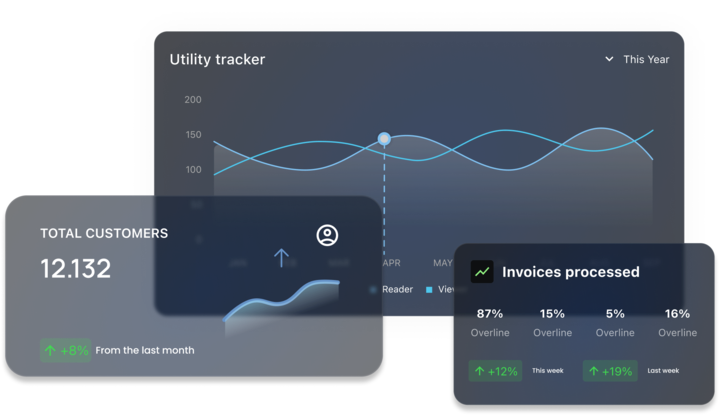CASE STUDY
Energy management platform
This energy management company automated 99% of their invoice processing thanks to custom software.
Tech stack/tools we used: .NET, JavaScript, Azure, Windows Communication Foundation, MS SQL, Teams, Outlook, Jira


- $4M
investments raised
- x4
times profit increase since 2016
- 35,000
clients onboarded
- 100,000
app users
- 99%
of invoices are processed completely automatically
- 20
years on the market
Client
A US-based energy management company was founded to help businesses orient in a chaotic world of utility bills
Their web application receives utility bills in diverse formats from various data providers and uses embedded algorithms to recognize and analyze the utility data. The algorithms then compile the data in a resulting report that shows the businesses their current expenses, potential budget savings, and future projections for the utility bills. This business intelligence tool helps businesses across the United States to save significant time and hundreds of thousands of dollars on utility expenses.
Problem
Loss of clients to competitors pushed the energy management company to reevaluate the software's quality and ultimately change the solution development vendor
When the client reached out to Syberry, the app was developing slower and was more unstable than the others on the market, so the business was losing its biggest clients to competitors.
Solution
Smart and mature application to ease the new businesses onboarding
Upon taking over from the previous team, we immediately started enhancing the system's foundation. Migration to Azure from outdated Team Foundation Server enhanced version control, and setting up CI/CD accelerated build times by 12x, enabling the removal of two DevOps Engineers.
We upgraded project engineering practices to industry standards, incorporating the agile methodologies, clean coding, and thorough documentation. This streamlined the development, allowing us to deliver increments on a weekly basis. The swift stabilization of the application also eliminated the need for 24/7 support.
As our client pursued a robust market strategy, we seamlessly onboarded smaller clients implementing engineering solutions for larger clients' specific needs. Integration with large data providers posed various challenges, resolved through API integration or data extraction algorithms with automatic validation checks.
With remarkable optimization efforts, our engineers handled scaling challenges by refining storage practices and code, that led to dramatic efficiency improvement. Notably, we introduced a carbon footprint calculation feature, aiding clients in emissions reduction and sustainability efforts.
I am especially impressed with their willingness and ability to learn our business and our clients' needs, and then apply that understanding to all aspects of our engagement.
Cory Kowal
VP of Product, THG Energy Solutions
Challenge #1
Address the risk of data provider internal process changes
The integration with various data providers comes with an ongoing risk of their internal processes changes, affecting the integration via API and potentially impacting the functionality of the system. In a worst-case scenario, these changes may lead to the loss of data and users. To proactively manage this risk, we have developed alternative tools that enable us to import data even in the absence of direct integrations with the data providers.
Challenge #2
Save storage
Big data solutions demand expanding storage capacities, and simply buying more servers would be as reckless as buying a new apartment every time your home gets messy. With the release of every new feature and data flow, we consider how it will influence the storage and look for ways to optimize it. Doing that allows our client to save their budget on servers on premises.
Succeed faster with Syberry
If you submit a request today, your MVP will be ready
as early as December 26, 2025
Key features
Optical Character Recognition (OCR)
With some data providers unable to integrate with us on the API level, Optical Character Recognition (OCR) proves to be useful to detect the data from files in PDF format.
Integrations with the biggest data providers on the market
80% of the energy billing data comes from just a few giants on the market. Adaptation to these companies' data structure, algorithms, and systems allows us to seamlessly import and process terabytes of data every day.
Introduction of NoSQL to store the big data
With the use of NoSQL databases, we were able to optimize the client's data storage and process more data without buying additional servers.
The outcome
A growing enterprise that changed the businesses' attitude to energy management
YOU MIGHT ALSO BE INTERESTED IN...

Utility, Startups
Software that improves access to clean water
Explore how a custom software application lets developing countries' populations access safe drinking water. A startup with the ambitious goal of creating decentralized water systems in developing countries approached Syberry to engineer a web and desktop application that helps to provide uncontaminated water supplies in third-world countries. Despite the low-power limitations, we maximized the app’s functionality and developed features using just two gigabytes of computer memory.

Startups
Social media for photographers
Combining cloud storage with a social media management platform produced the go-to platform for a community of photographers.

Finance, Startups
Payment processing system for a B2B FinTech startup
This entrepreneur created a disruptive payment platform for small businesses. Our client, a dynamic B2B FinTech startup, is committed to empowering small businesses with streamlined payment solutions. They aim to revolutionize traditional payment systems by offering an all-in-one invoicing and bill pay platform that eliminates fees and simplifies transactions for businesses in the United States.

Utility
Updating legacy water management software
This well-established enterprise decided to get bold — and refactor their outdated custom software.
Succeed faster with Syberry
If you submit a request today, your MVP will be ready
as early as December 26, 2025